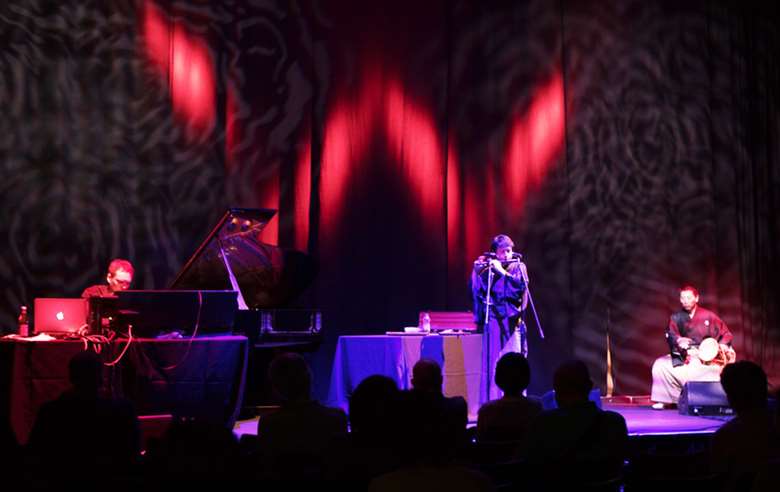There's Noh Limit: Space In Between At London's King's Place
Monday, July 9, 2018
This two-day festival that explores and extends the 650-year-old tradition of Japanese ritual performance art Noh is a welcome event, given the success of its previous 2016 edition.

Although the talks and workshops on what is a highly complex, codified form, where mask and movement as well as music all cohere with enormously rigorous discipline, are not without interest, the concerts, which bring together artists from different backgrounds, are fascinating. Tonight Japanese nokhan flautist Yukihiro Isso and British pianist Leon Michener pool their respective talents on the same stage where Isso memorably met Evan Parker two years ago, and though it is a relatively sparse audience in Hall Two, the smaller of Kings Place's two basement auditoriums, there is nonetheless a palpable sense of excitement as they take up position. Isso can be heard clearly due to the clapping of his wooden clogs under long-flowing robes. He walks to a table under the light on which no fewer than nine flutes are laid out. Dressed soberly in a black shirt and trousers, Michener approaches a Steinway next to which is an electronics station comprising laptop, synth and mixer.
As they start another minor sartorial detail comes into play. Michener is wearing a black glove. It is glimpsed by any eyes that follow him as he leans right into the body of the piano, and presumably enables him to tighten or loosen his grip on the strings and other inner mechanisms in order to produce startling timbres that range from dark, dense roars that flood the low register to higher-pitched scrapings, the net result of which conjures up an ambience of both enticement and foreboding. Unflinching in his posture, Isso proceeds to shatter into life with a violent maelstrom of sound that he sustains with astonishing consistency and accuracy as he moves from one flute to another without pausing for a moment. Later on, in a passage of Parker-esque circular breathing, he will negotiate a series of wavering harmonies where his intonation is so pinpoint sharp it sounds as if he is atomising a split tone. On some instruments he is piccolo-like, practically scorching the air by the ferocity of his attack, and on a curved animal horn he has a warm velvety muffle akin to an alto-flute. The volume at which he plays is as remarkable as the sustained flow of ideas, and it is telling that at no point in his exchanges with Michener, who crafts grainy textures and displaced phrases over a stark sub-bass throb, is Isso ever drowned out.
After Rahsaan-like multi-phonics through two or three flutes played simultaneously, and some discrete but effective motifs from Michener on piano, the pair unite on the highpoint of the performance; a gorgeous passage where they play short themes and variations back to one another, with the low, slightly hoarse tone of the flutes now like a child's recorder. It is innocence incarnate. Further excitement is generated by the arrival of Mitsuhiro Kakihara on otsuzum hip drum. Yet, as he sits a few feet away from Isso, he looks quite tentative. He executes the distinctive action of stretching his arm out in time with a vocal cry, but struggles to be heard amid the other instruments. His projection is smothered out. It is a slightly underwhelming episode on what is otherwise a fascinating adventure through an 'ancient to future' musical landscape.
– Kevin Le Gendre
– Photo by Mayumi Hirata